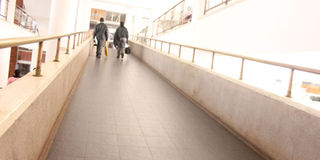When the pwds are Denied access to buildings

Garden City shopping centre in Kampala has a ramp that leads to its floors. Such facilities on public buildings do not discriminate against PWDs.
What you need to know:
Architects and developers should come up with designs for public infrastructures, bearing in mind they can accomodate all people, including the disabled. However, this is not the case as many disabled people are denied access to many public services, because developers claim a lot of expenses goes into putting up such facilities.
I bumped into Nelson Dumba, a father of two, on the fourth floor of Container Village Plaza, located in Kampala’s central business district. He was sweaty and his limbs were stained with dust – the effects of crawling on his buttocks all the way from the ground floor. Before starting our conversation, he attempted to remove a hankie from his pocket but changed his mind when he realised that his hands were dirty. Instead, he used his arm to wipe away the beads of sweat that had formed on his forehead. Thereafter, he cleaned his arm by rubbing it against his black shorts.
“I crawl up to this floor twice a week to purchase second hand shoes. The journey is a painful one both physically and psychologically. By the time I reach my destination I am as untidy as you see me. That is why I only buy from two shops. The attendants in other shops treat me contemptuously unlike the former. It really hurts. I have a wheelchair but I leave it at the ground floor since I can not move it over these steps. I believe the situation would be different if the building had facilities that made it possible for me to move in my wheel chair,” narrates Dumba.
The situation is not any better for the physically disabled who work in government owned buildings. Angella Balaba, a councillor in Makindye Division, says she has to be carried by her colleagues in order to participate in meetings at the division headquarter and at city hall. “Crawling would make me dirty. So, my colleagues lift me out of the wheel chair and take me to the venue of the meeting. When I have appointments I usually request the official that I am going to meet to come down to my car. Some accept while others refuse. Such is the difficulty we face,” says Balaba.
The experience of the two represents the plight of hundreds of people with disabilities in using majority of the buildings in the country. The state of the physical infrastructure in the country is a bane to the lives of most of these people. Most of the buildings do not have lifts, ramps, handrails, grab bars, tactile markings at the staircase end and appropriate door handles among other facilities. Some ramps are more of inclined planes. A 2007, Building and Construction report by The Ministry of Works, Transport and Communication revealed that 95 per cent of the buildings in Kampala, Mpigi and Wakiso are not accessible.
Such a status of infrastructure leaves the disabled more disabled because a PWD is less likely to depend on others for a living when he/ she can easily access a school, healthy facility, place of work, markets and banking halls. One is left wondering whether there are no laws to address the situation.
Ark Goffin Candria, the chairperson of the National Council for Disability, says there are a number of legislations such as the People With Disabilities Act and the Convention on the Rights of Persons with Disabilities that have sections that call upon property developers to put in place measures which ensure that the physically disabled can easily maneuver in the buildings. However, he reveals that most of these laws do not go beyond the papers on which they are written.
“These laws are not easy to implement, because there are no enforcement mechanisms.
Thus, there is nothing to fear as a result of non compliance,” says Candria, adding that, “Many developers who beat the system to erect buildings with no accessibility facilities for PWDs argue that they are not aware of the existing laws that require them to provide accessibility. Others argue that there are no economic returns to providing these accessibility measures since most PWDs are amongst the poorest of the poor and comparatively few in number.
It therefore does not make economic sense to incur extra costs in putting up lifts, elevators and ramps where they are not going to recoup in return. This has mostly been in the cases of hotels. There is also the lot that protests, that the cost of providing ramps and lifts in a building increases their cost of construction beyond their means and therefore makes it impracticable to implement, especially remodelling old buildings.”
Disability is not anyone’s choice
In reply to property developers who argue that it is expensive to install accessibility facilities in their buildings, Phylis Kwesiga, the CEO of K.K Consulting Architects, says expensive is a relative term in reference to the right for all persons to be able to access public facilities. “Note that any of us could become disabled in an instant, say from a car accident, so ‘expensive’ would directly relate to limited knowledge on what the standards are about exactly, for example accessibility can be improved simply by providing a tap lever handle that someone with fingers impaired from disease can use with an elbow, or levelling a path to have a gentle incline towards a pit latrine,” says the architect.
One of the instances where the aforementioned laws have been invoked to seek redress is in a 2009 case between Centenary bank and some PWDs from Gulu. The latter successfully sued the former after finding it burdensome to enter the bank’s branch in Gulu. Consequently, the Centenary bank ordered all its branches countrywide to put in place accessibility measures for its PWD customers.
When asked why there have not been similarly successful suits, Laura Kanushu Opori, the Executive Director, Legal Action For Persons with Disabilities Uganda, says most PWDs are not aware of their rights and therefore cannot claim them. She adds that those who know their rights are poor and afraid of the court processes because some believe that court is cumbersome and expensive.
Kanushu states that her association is currently pursuing cases against Kampala Capital City Authority, Makerere University Kampala and the Attorney General regarding inaccessibility. “We hope that if we win these cases, it will set a big precedent in the realm of accessibility,” remarks Kanushu.
What is noteworthy is that some of the premises of the courts of law such as the High Court, where the above cases are heard, also do not have facilities for accessibility by PWDs. Thus PWDs have to crawl to justice!
Nevertheless, there is no doubt that there is always a solution to every problem or challenge. The pain that PWDs face while using most of the building can be brought to an end. So, what is the way forward?
In 2010, the Uganda National Association of People with Disabilities formulated the Accessibility Standards in order to guide architects, property developers, policy makers and implementers on the accessibility requirements in the physical environment during the design and implementation of construction projects. They include the uniform standards which are to be applied in the design, construction and alteration of buildings and facilities.
George William Nokrach, Member of Parliament for the disabled in northern Uganda, says they are lobbying for Parliament to make the Accessibility




